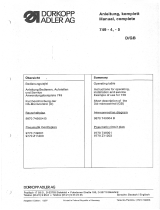
Part 3: Service Instructions
1. Notes prior to adjustment
These servicing instructions describe the
adjustments to the sewing unit in the appropriate
order.
Here it is to be noted that the various adjustment
positions are interdependent. It is therefore
essential that the adjustments be made in the order
described.
Attention Danger of Breakage!
After disassembly and prior to restarting the
sewing unit, the required adjustments must
be made as described in these instructions.
The sewing unit must not be started with the
wrong direction of motor rotation.
Attention Risk of Injury!
Should adjustments have to be made in the
area of the needle and the needle not be
absolutely necessary to these, it should be
removed to avoid injuries.
The main switch should always be turned off.
The only exceptions are those adjustments
which must be made with testing, setting or
sewing programs from the control unit.
Attention!
With some adjustments it is necessary to move the
transport carriage manually.
This is possible with the main switch OFF.
When the main switch is ON, e.g. when the testing
program is to be used, the step motor is under
current and its braking effect stops manual
movement. In this case the fuse 3 for the step
motor must be removed from the control panel.
For all adjustments to parts forming stitches a
faultless needle must be used.
Upon request you will receive the following
adjustment gauges:
Order no. Application
933 80207 Dail gauge
933 80193 Angle for the looper symmetry setting
933 80194 Indicator for the looper symmetry
setting
933 80200 Feeler gauge for the thread take-up
disk
933 80203 Gauge for the hook drive housing
933 80221 Gauge for the rocker bolt in the hook
drive
An adjustment disk in the machine head has the
notches A,B,C and D. An arresting pin, order no.
211700, for locking into the various adjustment
positions can be found in the package with the unit.
In conjunction with the letters on the handwheel the
arresting pin can be pushed into one of the notches
through a hole.
2.
Transport carriage
Caution in the area of moving machine parts
- Risk of Injury -
The transport carriage is guided on the extension
pipes at the front by the ball sleeves 2 and at the
back by the track rollers 1.
They have been set tight at the factory. To remove
axial play only loosen the excentrically bearinged
lower rollers 1 and set tight. Check for ease of
movement.
The transport carriage is advanced by the step
motor for the following speeds: Stitch condensing,
Normal stitch length and transport carriage return.
Through a coding on the material stopper it is
possible by primary seams to reduce return speed
for a partial or complete run according to the rail
form. See 5.1.10 of the Microcontrol summary.
1
2
3
3




























